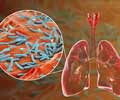
HIV and Tuberculosis
Go to source). “The two worst global health problems have combined forces well. But the institutions addressing them have miserably failed to put their act together,” wrote Dr Tim France, a noted global health thought leader, in an op-ed article titled “The chasm between TB and HIV” which was widely published in several newspapers of high TB burden countries in Asia Pacific and Africa in 2006.
‘Did You Know?
Globally, around 10% of TB cases are estimated to occur in people living with HIV, highlighting the intersection of these two infectious diseases. #tuberculosis #tb #hiv’
Tweet it Now
Globally, around 10% of TB cases are estimated to occur in people living with HIV, highlighting the intersection of these two infectious diseases. #tuberculosis #tb #hiv’
Advertisement
Renewed Urgency in Breaking Healthcare Silos
“Many of the [TB and HIV] programs are operating in isolation and almost in conflict with each other and it is not helping the patients [co-infected with TB and HIV] we all serve. There are many missed opportunities for HIV and TB service access in the Asia Pacific” said Eamonn.Asia Pacific is home to 21% of those who are co-infected with TB and HIV. “One-third of HIV treatment service providers do not provide TB treatment and three-fourths of TB service providers do not provide HIV treatment. This gap has got bigger over time, and we need to work collectively to bring this down and make the programs connect and work together” said Eamonn.
“I have been to hospitals where in the compound you have a TB clinic in one part, and an HIV clinic in the other part - and the staff never talk. Only a quarter of countries in the Asia Pacific region include TB preventative treatment in their national HIV policies and guidelines,” added Eamonn. Over 1.9 million people living with HIV will receive TB preventive treatment in 2022 globally.
“The ‘one patient two clinics’ bottlenecks of TB HIV care - must become obsolete. There should be a commitment to joint programming that is a fully integrated model of care where all services for both TB and HIV are provided in a single facility and by the same service providers. We need to bring the ‘silos’ together,” said Eamonn.
“As per the latest WHO Global TB Report 2023, around 48,000 people were co-infected with HIV and TB, and 11,000 of them died of TB in India. When TB is preventable and curable then even one TB death is a death too many. No one needs to die of HIV or TB,” said Professor (Dr) Dilip Mathai, President of the AIDS Society of India (ASI), and former Head of the Medicine Department, at Christian Medical College Vellore. He gave an unequivocal call to find all TB, treat all TB, and prevent all TB among people living with HIV.
Advertisement
Bridge the Gap Between “What We Know” and “What We Do”
Science has gifted us tools and evidence-based approaches to ensure that no one dies either of HIV or TB, and no one gets infected with either of them - provided - we bridge the gap between ‘what we do’ and ‘what we know works.’We have highly accurate diagnostic tests (molecular tests) to diagnose TB, the latest treatments that are less toxic, shorter, and more effective, and evidence-based ways to prevent TB and stop the spread.
We have proven ways to ‘reach the unreached’ with people-centered and community-driven “lab on the wheels” and provide a range of TB and HIV healthcare services on people’s doorsteps (or as close to the communities as possible).
Despite knowing how to break the chain of TB transmission and reduce human suffering, over 10.6 million people suffered through the disease and 1.3 million died in 2022 globally (as per the WHO Global TB Report 2023).
More than half of those diagnosed with TB in 2022, got a TB test that underperforms (microscopy) and not a molecular test upfront.
A similar paradox for HIV: we have accessible and good HIV tests, lifesaving antiretroviral therapy, and science to show that if a person is virally suppressed then undetectable equals untransmittable (U equals U which means there is zero risk of transmission of HIV virus from the person to anyone else).
“We can end AIDS now as science has shown us the evidence on how to stop the spread of HIV infection and keep people living with HIV healthy. To end AIDS, we need to ensure that no one is excluded,” said Dr Ishwar Gilada, President Emeritus at the 15th National Conference of the AIDS Society of India (ASICON 2024) and Governing Council member of the International AIDS Society (IAS).
“When a virus (HIV) and a bacteria (TB) can work so well together - why cannot we?” had said Michel Sidibe in 2009. Michel Sidibe was UNAIDS Executive Director back then and speaking to CNS (Citizen News Service) at the Stop TB Partnership’s Partners Forum in March 2009 in Rio de Janeiro, Brazil.
Despite knowing how to protect people with HIV from TB, 167000 people who were living with HIV died of TB in 2022 globally.
HIV continues to be the 2nd biggest risk factor for TB worldwide (undernutrition is the largest risk factor globally). Almost a million new TB cases were attributed to HIV as a risk factor (out of 10.6 million people) in 2022 worldwide.
“TB remains the leading cause of death for people living with HIV globally. In 2021, almost one-third of AIDS-related deaths were due to TB. Yet we dare to imagine a world where we find all TB, treat all TB, and prevent all TB among people living with HIV and others in the community,” said Eamonn Murphy of UNAIDS.
UNAIDS regional leader Eamonn Murphy said that TB and HIV collaborative activities have shone a spotlight on the value of ‘breaking out of the silos’ to tackle both diseases in a coordinated manner. Globally steepest reduction in TB deaths has been among people living with HIV.
Advertisement
From Op-Ed to Summit
“Our best successes have been in countries and communities where they have brought these silos together. 13 million TB deaths were averted among HIV-positive people between 2000 and 2021. We have seen a 67% drop in TB-related deaths among people living with HIV since 2010 globally. We are within reach of the 80% decline target for TB-related deaths among people living with HIV by 2025,” he said.“Perhaps our target was not as ambitious as it could have been, but we still have a long way to go to make sure we can achieve that and there are many other targets and competing demands in the current environment that are challenging us” he shared.
Progress has plateaued particularly since COVID-19 service interruptions. “Only 46% of the estimated 73,000 people living with HIV who developed TB in 2021 were able to access antiretroviral therapy. This is the same level as of 2020,” shared Eamonn.
Overall, TB cases in Asia and the Pacific region have not declined much between 2015 and 2022 among people with HIV.
More importantly, Eamonn pointed towards the difference between countries in responding to TB and HIV dual epidemics. “Over 75% of people diagnosed with TB accessed HIV testing and knew their status in 2022 but there is dramatically unequal progress between countries in Asia Pacific region.”
Only 58% of people with TB-HIV co-infection knew their status in 2022 and less than half of them (42%) were on antiretroviral therapy.
In India, over three-fourths of people with TB and HIV co-infection were on antiretroviral therapy whereas in the Philippines only one in five of them were receiving the therapy. “The data tells us a perennial story that people continue to be left behind.”
“We need a well-coordinated and persistent approach to both TB and HIV, for the delivery of comprehensive quality services,” said Eamonn. “We need a response that is strongly connected to the Universal Health Coverage (UHC) agenda and the 2030 sustainable development agenda. We cannot talk about achieving these or any other SDG targets if we continue the standalone programs and approaches.”
“Biomedical HIV and TB prevention and treatment strategies have saved millions of lives, but they are insufficient to meet our goals to end TB or AIDS. We know from more than four decades of building and refining the AIDS response that we have to involve the users of the health services in their design, planning, and implementation – at every level and stage. That is why communities at risk must be at the center of everything we do,” said Eamonn Murphy of UNAIDS.
We only have 80 months left to deliver on all SDGs which includes the targets of ending AIDS and TB worldwide (by 2030). There is no excuse for inaction - as we can do better.
Reference:
- HIV and Tuberculosis - (https://www.who.int/westernpacific/health-topics/hiv-aids/hiv-and-tuberculosis)














